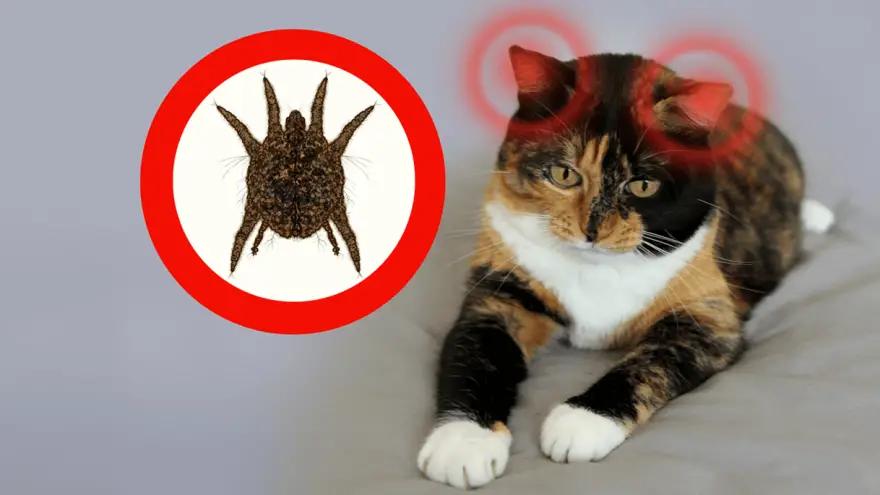Ear Mites in Cats: Symptoms, Diagnosis & Treatment
11.03.2022.
When we mention parasites, most cat owners automatically assume parasites like ticks, fleas, or different internal worms. However, there are other parasites that live in the cat’s ears. They are called ear mites, and even though they’re not life-threatening, they can make your cat’s life a lot harder. If you suspect your cat might have ear mites, here are a few things you should know.
What are ear mites?
The first thing we need to clarify is what ear mites are. We already said they are parasites, but the exact species is Otodectes cynotis. These topical parasites can infect different species and are commonly found in cats, dogs, rabbits, and ferrets. Ear mites are very contagious, and even quick contact with an infected animal can result in ear mite spreading. They are pretty hard to notice because they’re tiny and can only be seen as white spots moving on a dark background.
How can I know if my cat has ear mites?
There are a few tell-tale signs cats have ear mites. Most cat owners will notice their cats are experiencing ear problems, and even if we don’t know the exact cause at first, we should start suspecting ear mites pretty soon. The cat will show obvious signs of ear discomfort, such as scratching or head shaking. Another sign cat owners will notice is the specific bad odor coming from the cat’s ear. It is a good idea to learn ear mite symptoms, so you can make an educated guess about what’s bugging your cat.
Ear mites symptoms
All parasites, internal and external, will cause some symptoms. However, some internal parasites, like tapeworms, don’t cause many problems for cats. Ear mites are not like that. They will cause lots of discomfort and itching, making it pretty hard to miss them. Here are the most common ear mites symptoms in cats;
- Crusted rash around the ear
- Hair loss patches
- Aural hematoma (a large blood blister caused by too much scratching)
- Head shaking
- Ear scratching
- Dark, waxy ear discharge
- Ear irritation
- Bad smell

In the early stages of infestation, the cat might not exhibit all of these symptoms. It is vital to regularly check the cat’s ears and make sure they are in perfect condition.
How are ear mites diagnosed?
The good news is that ear mite diagnosis is pretty straightforward. Most vets will observe the cat’s affected ear with an otoscope or collect a bit of the ear discharge and observe it under a microscope. The vet will most likely ask you about possible contacts with other animals you might suspect have ear mites.
One thing that makes ear mite diagnosis slightly tricky is that other ear infections can have similar symptoms. If the vet can’t see the mites immediately, they might want to approach the diagnosis by eliminating other possible causes. Keep in mind that the cat can be in a lot of pain, so don’t be surprised if the vet has to sedate your cat in order to examine it properly.
WORLD CAT FINDER TIP: Ear mites are highly contagious, and they can quickly be passed from one cat to another. However, they can also be passed between species. That means that if your cat was in contact with an infected dog, it is at risk of contracting these parasites.
How are ear mites in cats treated?
To understand the treatment of ear mites, you need to first understand the parasite’s life cycle. Ear mites develop in three stages - eggs, larva, and adult. Adult mites can reproduce, and the process from egg to adult lasts about three weeks.
Several FDA-approved insecticides can be used for treating ear mites in cats and dogs. Your vet will know which medication is the best option for your cat. However, no medication can penetrate the ear mite egg, which means the treatment should last at least 4 weeks. The drug will eliminate adult mites and larvae, but eggs still remain. They can only be eliminated when they reach the second stage of their life cycle, which can take time. Ear mite medications can be topical, injections, or oral.
WORLD CAT FINDER TIP: Many products that keep your cat free of fleas are effective against ear mites. For example, Revolution or Simparica for cats is an effective way of dealing with these parasites.
Can I get ear mites?
Ear mites can infect different species, but the good news is that we are not one of those species. Dogs, cats, ferrets, and rabbits can get them, as well as various wild animals. However, you should remember ear mites are incredibly infectious, so make sure your infected cat is isolated and away from other pets that are at risk.
World Cat Finder Team







Share